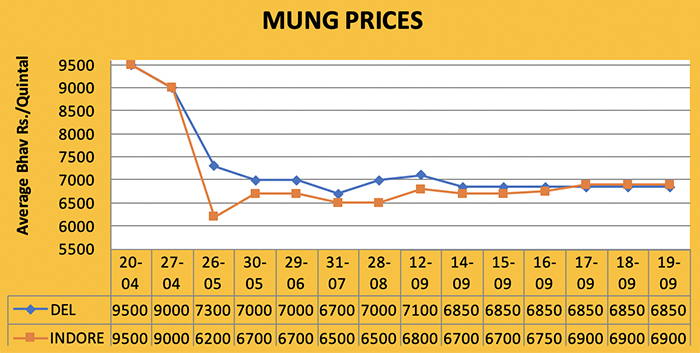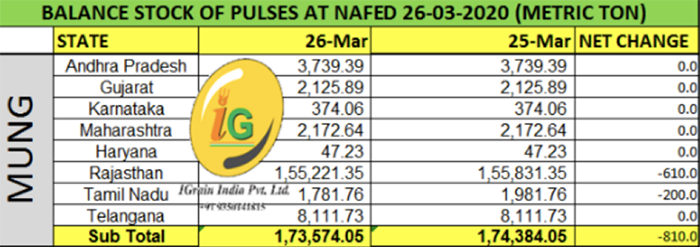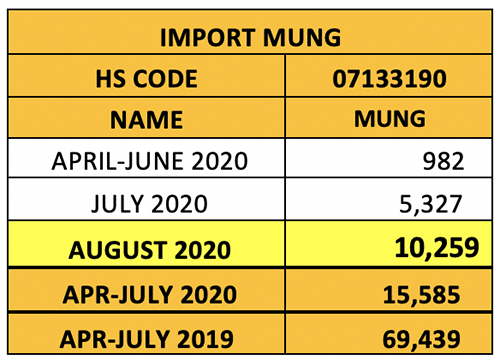September 21, 2020
IGrain’s Rahul Chauhan provides information on pricing and current inventories, as well as import figures and news from domestic and international markets.

New crop moong has started to arrive in Rajasthan. The arrival of Mogar quality moong in the mandis of Karnataka and Maharashtra is increasing daily, but the moisture level is high. During this past week, rains in Maharashtra affected the arrival of moong. Sporadic arrivals started in Rajasthan. There was a price spike due to the short supply of good quality moong. Stockists stopped selling old moong, which kept prices high. During the current week, Delhi Moong prices rose by Rs 100 to Rs 6,600/7,100 per quintal. Demand is expected to remain normal.
Karnataka
Moong quality has been affected by excessive rainfall in Karnataka this year. Production is expected to be excellent with increased sowing. During the current week, there was an improvement of Rs 100/200 in moong prices in the mandis of Karnataka. With this improvement the price in Gulbarga rose to Rs 3,500/7,800, Yadgir Rs 4,585/7,992, Bhalki Rs 5,311/6,200, Gadag Rs 4,950/5,292 and Bagalkot Rs 5,674/8,221 per quintal. Arrival of local quality moong may affect the market in the coming year. Government procurement is also expected to begin soon. If the government procurement process is good, then the market may remain stable.
Maharashtra
The arrival of moong in Maharashtra has started increasing. After hearing the news of crop damage, traders showed interest in buying. Moong prices jumped Rs 100/300 during the past week. With this boom, Latur prices reached Rs 5,000/7,550, Ahmednagar Rs 3,500/5000, Jalgaon Rs 6,300/7,000 per quintal. Trading at other market yards was also done at increased prices.
Rajasthan
The arrival of new moong has started in the mandis of Rajasthan. The price of moong in the mandis of Rajasthan rose by Rs 100/200. With this increase, Jaipur prices reached Rs 6,100/6,500, Jodhpur Rs 6,400/6,600, Merta Rs 4,400/6,000, Kishangarh Rs 4,500/6,800 rupees and Kekri Rs 3,500/6,300 per quintal in past weekend. Demand is expected to increase.
Others
Indore Moong recorded an increase of Rs 300. With this boom the price reached Rs 6,800/7,000. The price of moong in Pipariya rose by Rs 300 to Rs 4,000/6,300 per quintal. Jhansi moong saw no slowdown and prices remained steady at Rs 5,400/5,500 per quintal. The arrival of moong is expected to increase and prices should soften.



Average market price of most essential commodities increased in August (Dated 19.09.2020)
New Delhi. Data compiled by the Price Monitoring Cell of Consumer Affairs in Union Ministry of Food Consumer Affairs and Public Distribution show that the average market price for the list of 22 essential commodities during August 2020 is higher for some items and lower for others.
According to the information received, the average market price of rice was Rs 34.21 per kg in July, which improved to Rs 34.54 per kg in August. Similarly, the average price of wheat also improved slightly. The price of wheat flour fell from Rs 31.20 to Rs 31.11 per kg.
In the category of pulses, the price of gram dal declined from Rs 66.48 to Rs 66.36 per kg, Arhar (Tuar) pulses slipped from Rs 93.14 per kg to Rs 93.03 per kg, Urad dal price decreased from Rs 100.15 to Rs 98.71 per kg, The price of moong dal fell from Rs 106.92 per kg to Rs 103.52 per kg while the price of masoor dal improved from Rs 76.70 per kg to Rs77.35 per kg.
In the category of edible oils, the price of packaged groundnut oil was Rs 149.23 per kg compared to Rs 149.25 per kg, mustard oil price increased from Rs 122.09 per kg to Rs 124.48 per kg, vegetable (ghee) price improved from Rs 90.84 per kg Rs 91.38 per kg, soybean oil price improved from Rs 101.78 per kg to Rs 102.20 per kg, sunflower oil price rose from Rs 112.86 to Rs 113.15 per kg and palm oil price improved.
Reduction in customs duty will increase lentil imports (19.09.2020)
New Delhi. The central government has once again reduced the import duty on lentils from 30% to 10% (for U.S. origin, from 50% to 30%), this time for the period starting on September 18 through October 31. The government had previously reduced the tariff in the June-August quarter, and 4.50 lakh MT of lentils were imported at that time. With the tariff reduction reinstated, Indian importers are again actively buying from Canada. Lentil prices have remained firm despite the arrival of new crop.
According to the information received, large green lentils from Western Canada are priced at 29-30 cents per pound and red lentils at 24-25 cents per pound. Australia currently has limited stocks of lentils available for export. Most of the inventories were traded during the June-August quarter.
India is the largest consumer and importer of lentils in the world, and the second largest producer. Canada is the top producer and exporter. The harvest and processing of the new crop is in the final states, and there are signs of an excellent crop. There are sufficient exportable supplies of lentils. Nearly 80% of India’s lentil imports come from Canada and the remaining 20% from other countries, including Australia.
According to the fourth advance estimate of the Union Ministry of Agriculture, the production of lentils in the country during the 2019-20 Rabi season was 11.80 lakh MT, a 50,000 MT reduction from 12.30 lakh MT in 2018-19. It is to be noted that the Ministry of Agriculture’s third advance estimated pegged lentil production at 14.40 lakh MT.
According to data received, the first time lentil tariffs were reduced, India imported 73,442 MT in June, 166,620 MT in July and 207,592 MT in August. From September 1-17, the tariff reverted to 30%, but from September 18, it was slashed again to 10%.
Lentil is the major pulse crop grown during the rabi season. It is produced mainly in Uttar Pradesh, Bihar and Bengal. Planting is likely to start next month with harvest in March-April of next year.
Crop damage due to excessive rains (18.09.2020)
New Delhi. The Meteorological Department forecast monsoon rains in major pulse producing states, including Maharashtra, Karnataka, Madhya Pradesh and Rajasthan, during the second fortnight of the current month. This is expected to cause major damage to crops, especially in areas where sufficient soil moisture is already present and the crop has reached maturity. In August, torrential rains damaged Moong and Urad crops, and Tuar crops have also been damaged in northern Karnataka and some parts of Maharashtra.
There is a remarkable increase of 6 lakh hectares in the sowing area of pulses crops during the current kharif season compared to last year, but there is a doubt about the increase in the total production in view of the way crops are being damaged due to natural calamities. If it rains during the current month, the scope of damage will increase further. Pulses crops need sunny weather now. The market price of pulses has intensified due to the possibility of insufficient production and delay in imports. The prices of Mung, Urad and Tuar have risen to around or above the minimum support price.
Government's efforts to curb the rising prices of pulses started (18.09.2020)
Delhi. The government has stepped up efforts to control rising domestic pulse prices. The Consumer Affairs Department has sent a letter to all states and union territories informing them that they can lift whole moong or moong dal from the buffer stock.
For bulk offtake, the Food Ministry has offered states moong at a low (fixed) price. The price of whole moong has been fixed at Rs 77-78 per kg and moong dal (processed) at Rs 92-93 per kg. Pulses raised from central buffer stock can be sold through government retail outlets including fair price (ration) shops.
Pulses like arhar (tuvar), gram and urad are also likely to be included in this new scheme. But the price of moong has been kept so high that state governments will have to think before purchasing it. The minimum support price of moong has been fixed at around Rs 7,200 per quintal for the current season.
State governments have to decide on the option of lifting the stock of pulses in whole or bulk rupees. Apart from this, the state government can also order the supply of pulses in retail packs of 500 grams and 1 kg. It can be sold through PDS or through other retail outlets. The Food Ministry has asked the states to send the name of their nodal officer so that the process of pulses distribution can be started as soon as possible.
It is noteworthy that the price of moong dal has jumped Rs 104 per kg in Delhi and Rs 144 per kg in Mumbai. The center currently has a significant stock of pulses which are kept in the domestic market for the purpose of selling and distributing them under other schemes.
Senior officials of the Food Ministry say that prices for pulses have become very high and that the government has to intervene. The price of government pulses has been fixed on the basis of an additional sum of 10% in the minimum support price.
Doubts on spectacular production of pulses crops due to heavy rain and flood (18.09.2020)
New Delhi. Compared to last year, during the current kharif season, the area under pulses increased from 13 million hectares to 6 lakh hectares to 138 lakh hectares, and its production is expected to be excellent due to the weather and monsoon conditions being favorable in the initial phase. But during the month of August, heavy rainfall/ torrential rains, severe floods in the major producing areas of major producing states and heavy water logging in the fields, the production equation is expected to change.
The market price of almost all pulses rose sharply due to the news of widespread damage to crops. Earlier the prices of moong and Urad increased and now the market of Arhar (Tuar) is also going up. It is believed that the moong in Karnataka, Maharashtra and Urad crop in Madhya Pradesh and Maharashtra were damaged to a great extent. Flood rains in northern Karnataka are reported to have damaged the Tuar crop.
According to trade analysts, pulse prices have increased by Rs 600 per quintal in Maharashtra's benchmark Latur wholesale market. The price of arhar has jumped to Rs 6,500 per quintal, which is much higher than the minimum support price declared by the government at Rs 6,000 per quintal. In Latur mandi, the price of Tuar dal (processed) has increased to Rs 90 per kg, while in cities like Mumbai and Pune it has gone above Rs 100 per kg.
Abbreviations
Tuar/ Arhar Pigeon Peas
Mung Green Mung
Urad Black Matpe
Chana Gram
Matar Pea
Masur Lentil
Mandi Market yard
Bhav Prices
Dal Processed Pulses (Directly for human consumption)
Rs Indian Rupees (1usd= Rs 73-74)
Rahul Chauhan
Director, IGrain India
igrainind@gmail.com
+91 9350141815
Twitter rc_capricon
Disclaimer: The opinions or views expressed in this publication are those of the authors or quoted persons. They do not purport to reflect the opinions or views of the Global Pulse Confederation or its members.